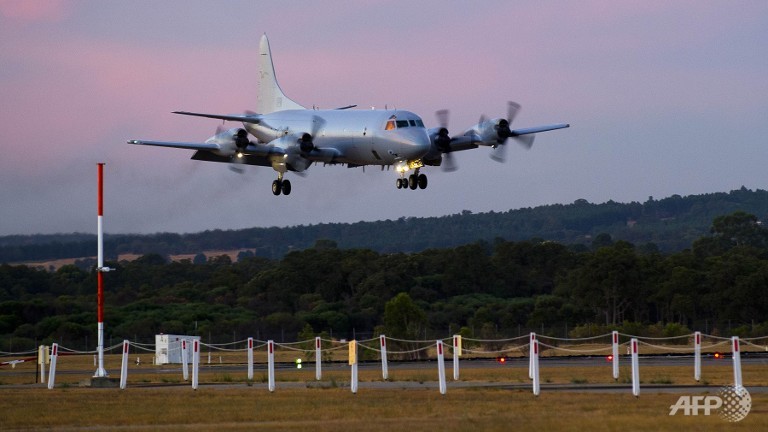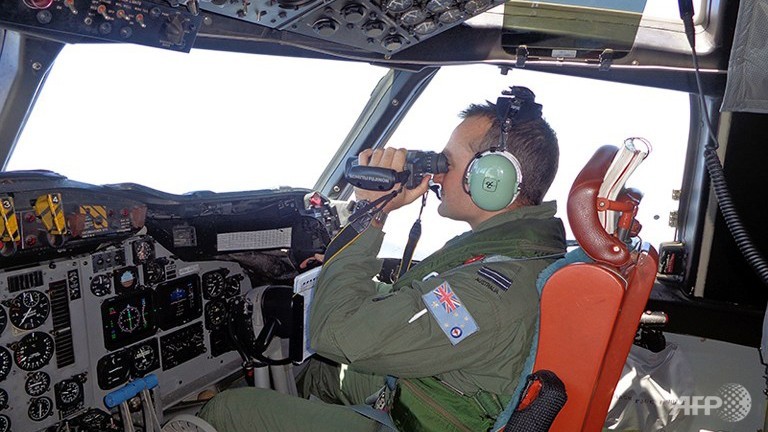Bad weather hampers search for possible MH370 plane debris

A Royal Australian Air Force AP-3C Orion aircraft arriving at RAAF Base Pearce in Bullbrook, Western Australia, following a sortie in support of the Australian Maritime Safety Authority-led search for Malaysia Airlines flight MH370 in the Indian Ocean.
(AFP/Australian Defence/Justin Brown)
CANBERRA: Bad weather conditions hampered search efforts in the Indian Ocean on Thursday for a pair of floating objects that Australia and Malaysia guardedly called a "credible" lead in the 12-day-old hunt for a missing passenger jet.
The crew of an Australian military plane sent out to search for the possible debris from Malaysia Airlines flight MH370 said bad visibility was hampering their efforts.
Australia said the objects -- one was estimated at 24 metres (79 feet) across -- were captured in satellite imagery, raising hopes of a breakthrough in the Malaysian plane's mysterious disappearance as relatives of the 239 people aboard braced for another emotional roller-coaster.
"We now have a credible lead," Transport Minister Hishammuddin Hussein said during Malaysia's daily briefing on the crisis.
"There remains much work to be done to deploy the assets. This work will continue overnight."
Four search aircraft were dispatched from Australia -- which has taken charge of the search in the southern Indian Ocean -- to the area about 2,500 kilometres (1,553 miles) southwest of Perth where the grainy images were snapped.
The planes -- two from Australia, one from New Zealand and one from the US -- covered an area of 23,000 sq km (9,200 sq miles) without any sighting before the search was suspended for the day, said the Australian Maritime Safety Authority (AMSA).

This photo shows a pilot of an AP-3C Orion maritime patrol aircraft scanning the surface of the sea during a search operation for the missing Malaysia Airlines Flight MH370. (AFP/Royal Australian Airforce)
It earlier reported cloudy, rainy conditions and limited visibility.
A Norwegian merchant ship reached the site as daylight waned, and another merchant ship was en route.
The Australian navy's HMAS Success was also headed for the area, and Britain also sent a naval survey ship, HMS Echo.
Clearly wary of raising hopes following a series of past false leads, Hishammuddin warned of delays in verifying the apparent debris.
The Malaysia Airlines Boeing 777, carrying 227 passengers and 12 crew, vanished in the early hours of March 8 after veering drastically off course over the South China Sea while en route to Beijing.
Investigators believe it was deliberately diverted but still don't know by whom, why, or where it ended up.
The satellite images, taken on Sunday, were first revealed earlier in the day by Australian Prime Minister Tony Abbott. The larger of the two was described as measuring 24 metres.
Abbott told parliament the images represented "new and credible information" but stressed that any link with flight MH370 had still to be confirmed.
"The indication to me is of objects that are of a reasonable size and probably awash with water and bobbing up and down over the surface," top AMSA official John Young said.
The images are the first solid clue since the search area was significantly broadened last weekend to take in a vast part of the Indian Ocean.
Experts said the fact that Abbott himself had released the information lent weight to its credibility, but warned it could be difficult to find the objects in an isolated corner of the Earth noted for strong currents.
"The current there is one of the strongest in the world, moving at as fast as one metre per second," said Gan Jianping, an oceanographer at the Hong Kong University of Science and Technology.
The Australian naval vessel HMAS Success, which is capable of retrieving any debris, is some days away from the site.
The objects would have drifted for four days, making them a "logistical nightmare" to locate, said Australian Defence Minister David Johnston.
"We are in a most isolated part of the world. In fact it probably doesn't get, if I can be so bold, more isolated," Johnston told Sky News Australia.
He was later quoted as saying it could take "two or three days" before any firm conclusions are made.
The search time for any aircraft is restricted by the roughly six-hour round-trip flight to the area, said Caj Frostell, a former official with the International Civil Aviation Organisation.
"In an eight-hour duration, your time of search is fairly limited because you need to have fuel to get back. That's why they need to have ships there also," he said.
Malaysia has been under increasing fire for an investigation and search viewed as disjointed and chaotic, especially from passengers' relatives who accuse authorities and the flag-carrier airline of insufficient or misleading information.
Nearly two-thirds of the passengers were Chinese nationals.
There was a mixed reaction to the news among families gathered at a Beijing hotel, who have clung for almost two weeks to slim hopes that the plane landed somewhere.
"My son is still alive. My son is still alive. I don't believe the news," cried Wen Wancheng, 63, as he pushed his way through a throng of reporters.
Others cited the previous sightings that went nowhere.
"I am sick of hearing there is new information only for it to be dismissed later," one man told AFP angrily.
There were chaotic and emotional scenes in Malaysia on Wednesday when a group of angry Chinese relatives tried to gatecrash the government's tightly controlled daily media briefing.
Malaysian security personnel bundled them away.
If debris is found, the new and challenging task will begin of finding the black box to help figure out what befell the plane.
Malaysia has asked the FBI to help recover data which it said was deleted from a home flight simulator belonging to the plane's chief pilot, Captain Zaharie Ahmad Shah.
Zaharie, a respected 33-year veteran of the airline, has come under suspicion since investigators concluded the plane's communication systems were disabled manually before it changed course.
US President Barack Obama, who is due to visit Malaysia next month, said on Wednesday he wanted anguished relatives to know Washington considers solving the riddle a "top priority".
What the stars mean:
★ Poor ★ ★ Promising ★★★ Good ★★★★ Very good ★★★★★ Exceptional
Latest News
More News
- 72 nations sign landmark Hanoi cybercrime convention (October 26, 2025 | 18:00)
- UN Secretary-General commends Vietnam’s global leadership (October 26, 2025 | 09:00)
- APEC finance ministers convene to tackle regional challenges (October 22, 2025 | 17:31)
- Rewiring global trade: ASEAN’s rise as supply chain hub (October 17, 2025 | 11:40)
- Vietnam attends first World Nuclear Week Forum in Russia (September 26, 2025 | 10:50)
- Vietnam attends 69th session of IAEA General Conference (September 16, 2025 | 10:00)
- ADB, WB pledge over 12 billion USD for ASEAN power grid, renewable energy projects (August 15, 2025 | 14:18)
- Lowy Institute proposes AI-based tobacco control solutions for ASEAN (August 15, 2025 | 14:14)
- Cloud computing policy to position Malaysia as regional hub by 2030 (August 15, 2025 | 14:11)
- Thailand, Cambodia suffer numerous cyber attacks (August 05, 2025 | 16:19)


















 Mobile Version
Mobile Version